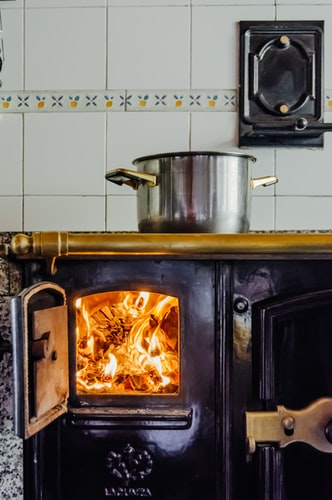
Searching for the definition of the word ‘stove’ brings up ‘an apparatus for cooking or heating that operates by burning fuel or using electricity’.
What is interesting about this is that for many people only the first half of that definition springs to mind immediately. The fact of the stove being used for heating and not cooking sometimes escapes people but a journey into the history of this device soon reveals that providing heat to protect people from inclement climates was the original purpose of stoves.
Ever since the discovery of fire humans have been using it for both cooking and primarily to keep warm. We can only imagine the open fires in caves or sheltered valleys of hundreds of thousands of years ago. Making use of fires for domestic purposes, that is indoors, started around the Middle Ages. As construction was extremely basic this would often take the form of a single large hall or room with a fire in the middle or side venting smoke through an opening in the roof. This type of construction would have lost a lot of heat to the atmosphere, would have been smoky and probably considered unpleasant in a home nowadays.
As time went by people began to find solutions for the problems above and the construction of stoves became a lot more sophisticated. Dedicated pipes, or flues, were used to direct smoke outside. The fire itself was contained in some way either by brick or later metal to better control the burn and preserve the heat where it was required.
The first recorded find of such a construction innovation was in Alsace and had a brick and tile construction all over including its flue. Later Scandinavian variants had long, hollow iron flues with baffles to maximise the heat extraction from the distance the hot, smoky air had to travel.
In the New World the first fully metal, cast iron stove came into production in 1642 in Massachusetts and was little more than an iron box to contain the fire. This was later developed further by the prolific inventor and US President, Benjamin Franklin, who constructed an airtight, cast iron stove closer to the ones we have now.
Nowadays stoves are much more efficient at heating the home and allowing fuller control of that heat while minimising loss, smoke and any ash or dirt. Newer stoves are available not just to warm the home but to complement it and fit in as a part of the considered décor and theme.
In terms of fuels there are dual fuel, electric, gas and wood burning variants. When it comes to the look and feel cutting edge modern designs compete with traditional and solid retro feeling pieces. When looking to warm a room for winter as well as the mundane ‘heater on the wall’ or ‘radiator’ we have the choice of making a statement with the right stove. There is a very wide range of types and styles online, a quick search of, for example, Raypal Stores can lead to some very pleasant unexpected surprises and considering the history of these devices it can be fun to hunt out one that is in keeping with a favourite era or theme adding enjoyment to the task of heating a room.




